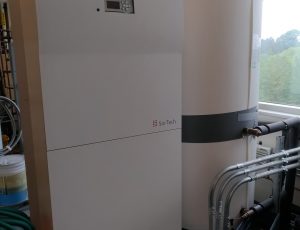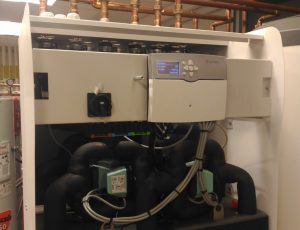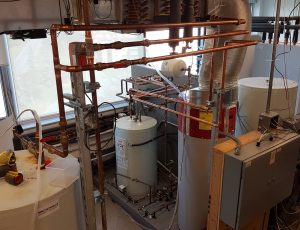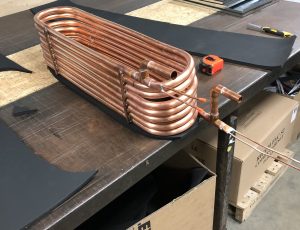- Adsorption Cooling for Residential Applications in Canada
- Solar Thermal assisted Heat Pump Water Heaters
- Retrofitted Trans critical CO2 Heat Pump for Domestic Water and Space Conditioning
- Solar Assisted Heat Pumps
Adsorption Cooling for Residential Applications in Canada
Project Lead: Jordan McNally
The purpose for this research is to determine through experimental and simulated results if adsorption cooling is economically feasible in residential applications. An adsorption chiller can be paired with a flat plate solar collector to produce cooling and heating for a home with little electrical input. Reducing electrical input will reduce costs as well as reduce carbon dioxide emissions.
The experimental setup includes a SorTech adsorption chiller which connected through a heat exchanger to a steam line for heat input, a dry cooler for heat rejection, and a air conditioning loop. Through utilizing control vales and pump controls we can simulate heat input into the chiller from a flat plate collector given solar data. A simulation model was created from a performance map generated from the experimental results.
The adsorption chiller model is incorporated in numerous system models to compare different system configuration to standard air-conditioners, natural gas furnaces, electric heating, and heat pumps. These simulations are run for locations in every province and some territories.
The results from this research aim to provide a system cost analysis as well as an analysis for which provinces will benefit the most economically and environmentally from this technology.
Solar Thermal assisted Heat Pump Water Heaters
Project Lead: Calene Treichel
The goal of the project is to decrease residential energy consumption and greenhouse gas emissions using a heat pump water heater (which uses a refrigeration cycle) in combination with a solar collector. Coupling the heat pump with a solar collector allows an increase for the feasibility by getting rid of that space heating increase.
Important factors are energy performance and economic performance of the water heaters and the solar connected water heaters.
The system was tested at different air conditions (flow rates, temperatures, humidities) to characterize the heat pump water conditions, and then experiments were run under air conditions that simulated solar collector outlet temperatures and used those to validate the TRNSYS model.
The model was tested in various cities across Canada and the United States to illustrate performance variations in terms of energy greenhouse gas emissions, and economics.
Retrofitted Trans critical CO2 Heat Pump for Domestic Water and Space Conditioning
Project Lead : Kayla Lewry
The goal of this research is to study a commercially available, retrofitted, CO2 heat pump water heater (HPWH) SANCO2 from Sanden. More specifically, the basic control logic of the heat pump and its performance over varying water and source temperatures. To move away from traditional refrigerants, testing must be done to learn about the properties of CO2 as a natural refrigerant.
This project is conducted in partnership with Ecologix, an industry partner of the Solar Energy Systems Laboratory.
The experimental process begins by numerically modelling the heat pump water heater (HPWH) and correctly predicting the state points based on varying ambient and water temperatures. The model is then used to try out different control strategies to determine what is currently being used for the Sanden unit. The model will then be converted to a water source configuration, with optimized controls.
Future work with this HPWH involves experimental testing in the SESL facilities. It is expected to be tested over various water temperatures and flow rates to better understand how different conditions will affect the performance of the heat pump.
Solar Assisted Heat Pumps
Project Lead: Ben Beauchamp
This research focuses on determining which configuration of the existing models of Solar Assisted Heat Pumps (SAHP) would hold the most promise for building integration in Canada. This work is being done in partnership with NRCAN, with the goal being to assess technologies for their potential to provide ultra-efficient heating.
A simplified model of each configuration being researched was inputted into excel, allowing for direct comparison and determining which model has the most potential. At which point the research will move into TRNSYS for more detailed modelling.







